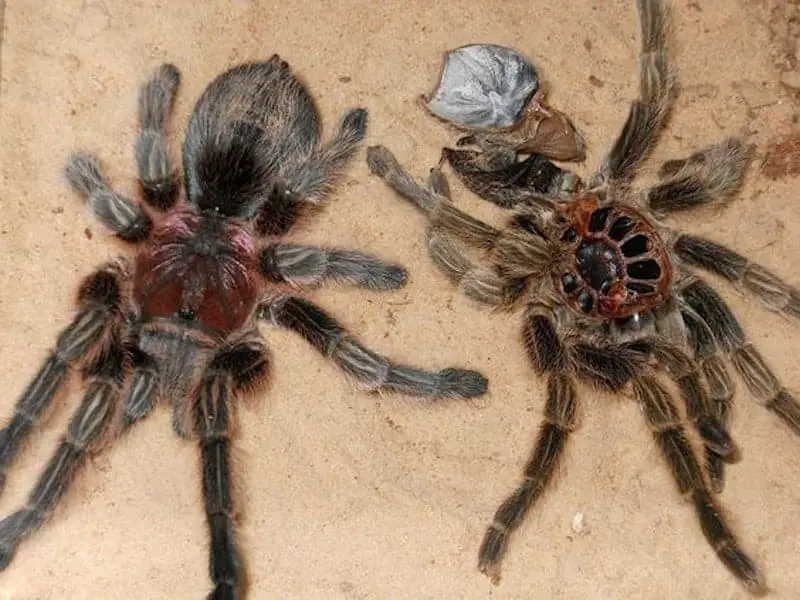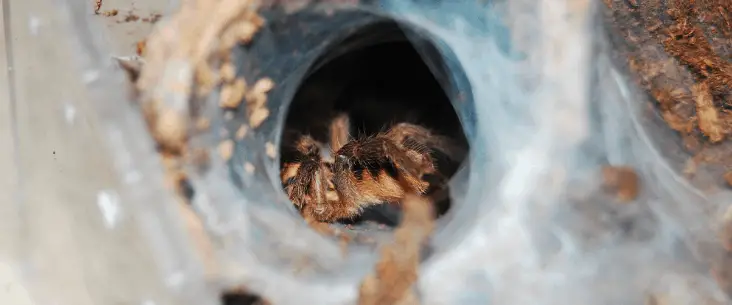Tarantulas moult several times in their life as a need to grow. With their hard exoskeleton, tarantulas can’t grow between moults. The hard exoskeleton protects the animal from injuries and can be compared with our skeleton; only tarantulas have them on the outer side of their bodies. You can imagine that changing their exoskeleton is a delicate process where the animal is quite fragile. A question that is frequently asked is if a tarantula can die during moult. We will discuss it in this article.
A tarantula can die while moulting but is often due to several factors and moulting should not be a problem for a healthy animal. During the process of moulting with tarantulas, the animal is very fragile and defenceless. When the tarantula gets disturbed is very stressful. It may result in bad moulting or getting stuck in its old skin, and this may result that the animal (eventually) dies. It is important to let the animal be and closely observe if everything goes well.
When a tarantula is on its back does not mean it is dead! A tarantula will lay on its back to position itself to moult and is completely normal behaviour for tarantulas. A dead or dying tarantula can be recognized by the “death curl”, where it folds its legs under his body.
What can go wrong during moulting?
A tarantula is extremely vulnerable during the moulting process and some hours after the moult and a tarantula should not be disturbed during moulting.
The most common problem with moulting is that a tarantula will get stuck inside the old exoskeleton. When they get temporarily stuck with just a small part of its body would not immediately mean that it is in trouble, but it can also get trapped inside its old exoskeleton (also called a carapace). When it is not able to crawl out of its old exoskeleton, it will slowly die of exhaustion, dehydration and stress.
Another problem that sometimes occurs is that the old carapace is getting stuck on one of its eight legs. This doesn’t have to be an immediate problem and should first be monitored. But when it stays stuck on one or more legs will cause the tarantula to be unable to move properly, or that it can’t climb or burrow. It is also exhausting for a spider to drag its old skin around.
One thing you should be looking out for is pests in the enclosure. As mentioned before, the tarantula is fragile and defenceless during moulting. Pest animals (for example uneaten crickets) can irritate and stress your tarantula which can cause other problems during moult. Make sure you don’t throw in any food before, during or immediately after moulting and remove any uneaten prey items before it starts moulting. Ants should definitely not be in the enclosure during the moulting process.
Tarantulas that are older, malnourished or have regenerated/malformed legs have a higher risk of having problems during moulting.

Should you help a tarantula with moulting?
No, you should not help a tarantula with moulting. When you disturb the tarantula during the actual moult will increase the risk that your spider is getting problems with moulting or is even deadly to your tarantula.
However, the only time you could consider intervene during moulting is if you see that your tarantula has pronounced trouble getting out of its old skin and when it takes more than 18 hours. But, keep in mind that any intervention still risks your animal to die, so you should only intervene when if you do not help it will die anyway.
Preventing moulting injuries or death
Of course, you can’t always prevent that your tarantula gets injured or dies during moulting. But a healthy, good nourished and up to middle-aged tarantula should normally have no problems getting through its moults, although some factors will help to make the moulting process less exhausting and stressful.
A correct or increased humidity in your tarantula enclosure is key for smooth moults. Humidity will assist a tarantula in getting out of its old exoskeleton easier. So, make sure that the drinking bowl is full before the actual moulting process starts (pre-moult). This will contribute to keeping the enclosure humid and the tarantula hydrated.
Always keep your tarantula well-nourished and hydrated. A healthy tarantula will have no problems during the exhausting moulting process. So, not only during moulting but always be sure that the drinking bowl is filled with enough and fresh drinking water. When a tarantula doesn’t eat is not a problem, but don’t let uneaten prey items in the tank.
Leave your tarantula alone and in peace before and during its moult, and 5 days after it is moulted. Absolutely do not touch, flip over, bury, blow on or spray it with water when a tarantula is on its back. This will be very stressful for your spider, and any needless disturbances have been proven to risk death for your tarantula.

Can you know when a tarantula will soon be moulting?
There are multiple signs that a tarantula will (quite) soon starts moulting (pre-moult). It is important to recognize these signs, so you know the tarantula is preparing for its next moult. The signs to recognize a tarantula is in pre-moult are:
- It stops eating: This sign will probably be the most obvious and common one your tarantula is preparing for its next moult. Don’t worry; a tarantula can stop eating for a couple of months without any problem.
- Its abdomen and/or overall body darkens: The new exoskeleton will form under the old one, often causing your tarantula to darken in colour.
- It may get thinner hair or bald spots on its abdomen: On the abdomen, it may lose more and more hairs and will get a “bald” spot that is quite dark and shiny. This will tell a moult is coming.
- It constructs a web mat or web hammock: Your tarantula may build a hammock or soft bed and will use that to moult on.
- It has decreased activity: You tarantula will not move as much as it normally does and when it moves it will be slower. Probably it is saving energy for its moult, and that’s good because it needs it.
When you observe one or more of these signs, you can almost certainly say your tarantula will soon be going to moult. The stage before the actual moult — pre-moult — is evenly important for your tarantula as it is preparing to get through its next moult and at this point already try to disturb your spider as less as possible. If this is the first moult you encounter, it can be quite tense and exciting, but when you have kept your tarantula healthy and in a good enclosure with all its needs, your tarantula will do perfectly fine.
Want to know more?
Do you want to know more about keeping and caring for tarantulas? Head over to our page on caring for a pet tarantula and find all information about housing, feeding, cleaning and create the perfect habitat.
Share this page!



